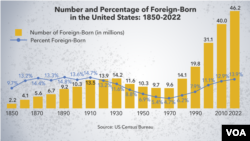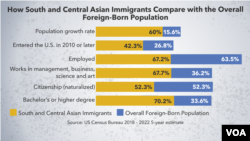The U.S. immigrant population from South and Central Asia has reached new heights over the past decade and continues to grow rapidly.
Recent data released by the U.S. Census Bureau shows that between 2010 and 2022, the number of immigrants living in these areas of the United States jumped from 2.9 million to nearly 4.6 million, an increase of nearly 60%.
This surge dwarfs the 15.6% increase in the total “foreign-born” population in the United States during the same period. Data Display.
Jenny Batalova, a demographer at the Migration Policy Institute, said the increase was “mind-boggling.”
“We are talking about a fourfold growth rate,” Batalova told VOA in an interview.
The Census Bureau defines “foreign-born” as anyone who was not a U.S. citizen at birth, including naturalized citizens and lawful permanent residents.
The U.S. Census Bureau reported on April 9 that the total foreign-born population in the United States in 2022 was 46.2 million, accounting for nearly 14% of the total population, compared with 40 million in 2010, accounting for nearly 13% of the total population.
The Census Bureau data underscore how much immigration patterns have changed in recent years. While Latin America was once a major source of immigrants to the United States and still accounts for half of the foreign-born population, more immigrants now come from Asia, Africa and other parts of the world.
The foreign-born population from Latin America grew by 9% between 2010 and 2022, while the population from Asia tripled, with South and Central Asia accounting for most of the growth.
“We’re reaching a wider range of countries than we did before,” said William Frey, a demographer at the Brookings Institution. “The old image of U.S. immigration was that it was just Latinos and Mexicans coming to the U.S. in large numbers, and that’s Incorrect.”
To understand immigration trends from South and Central Asia, VOA dug into census data and spoke with demographers. Here’s what we found.
How many immigrants from South and Central Asia live in the United States?
The Census Bureau places 10 countries in the South and Central Asia category: Afghanistan, Bangladesh, Bhutan, India, Iran, Kazakhstan, Nepal, Pakistan, Sri Lanka and Uzbekistan.
The agency’s foreign-born population estimates are based in part on a study called American Community Survey. Every estimate has a certain margin of error.
The foreign-born population from South and Central Asia was estimated at 4,572,569 in 2022, up from 3,872,963 in 2010. The margin of error is plus or minus about 55,000 people.
Indians, numbering more than 2.8 million, are by far the largest foreign-born group in the region. That’s up from nearly 1.8 million in 2010.
The second largest group comes from Pakistan – nearly 400,000, up from nearly 300,000 12 years ago; followed by Iran with 407,000, an increase of more than 50,000.
But on a percentage basis, several other communities in the area saw much larger increases.
The number of foreign-born Afghans jumped from 54,458 in 2010 to 194,742 in 2022, an increase of 257%. Batalova said this was largely due to the influx of refugees triggered by the Taliban’s takeover of Afghanistan.
“In terms of the rate of change, [Afghanistan] More than all other countries in South and Central Asia,” she said.
Foreign-born Nepalis had the second largest increase, from 69,458 to 191,213, an increase of 175%.
Immigration from Bangladesh and Uzbekistan increased by 91% and 60% respectively.
When and how do immigrants from South and Central Asia arrive in the country?
While Indians have immigrated to the United States for decades, a large proportion of immigrants from South and Central Asia are recent arrivals.
More than 42 percent of them entered the United States in 2010 or later, more than the nearly 27 percent of the total foreign-born population who settled during the same period, according to Census Bureau estimates.
Batalova noted that immigrants from South and Central Asia take different paths into the United States. For example, Indians rely heavily on student and work visas and family reunification.
Many Central Asians enter through the Diversity Visa Program, from which approximately 36% of Uzbek green card holders benefit. Bangladeshis also used to take advantage of the so-called “green card lottery,” but lost eligibility for the program in 2012 after 50,000 Bangladeshis immigrated to the United States in five years.
As for the recent influx of Afghan immigrants, most entered the country through the special immigration visa and humanitarian parole programs after the Taliban took over the country.
How do the educational levels and other characteristics of South and Central Asians compare with the overall foreign-born population?
Immigrants from South and Central Asia tend to have higher levels of education than the general population and are more likely to work in in-demand professional jobs.
More than 70% have a bachelor’s degree or higher, compared with nearly 34% of the foreign-born population overall, according to Census Bureau estimates for the 2018-2022 period.
Nearly 68% work in management, business, science and the arts, compared with 36% of all immigrants.
Immigrants from India in particular tend to enjoy high levels of education and professional jobs. Nearly 48% of Indians hold graduate or professional degrees, while more than 77% work in management, business, science and the arts.
Where do most immigrants from South and Central Asia live?
More than half of the immigrants in the United States live in four states: California, Texas, Florida and New York.
However, for immigrants from South and Central Asia, the top four states of residence are New Jersey, California, New York, and Virginia.
In New Jersey, located in southern New York state, foreign-born South and Central Asians make up 3.6% of the state’s population of 9 million. In California, they make up 2.31% of the state’s population of 39 million.
How big is the diaspora community?
The foreign-born population from South and Central Asia should not be confused with the number of U.S. residents who say they are from that region.
The expatriate community is larger, including second- and third-generation immigrants.
Demographers at the Migration Policy Institute estimate that about 5.2 million people in the United States identify themselves as “South Asian Indians.” About 250,000 people claim Afghan ancestry.
The 2020 U.S. Census found 687,942 people identified as “Pakistani alone” or in combination with other groups, far more than the estimated 400,000 foreign-born Pakistanis in the U.S.
As for other expat communities in the area, “they won’t have many [larger] More than the total immigrant population, just because they are a newer immigrant group,” Batalova said.
Follow us on Google news ,Twitter , and Join Whatsapp Group of thelocalreport.in



